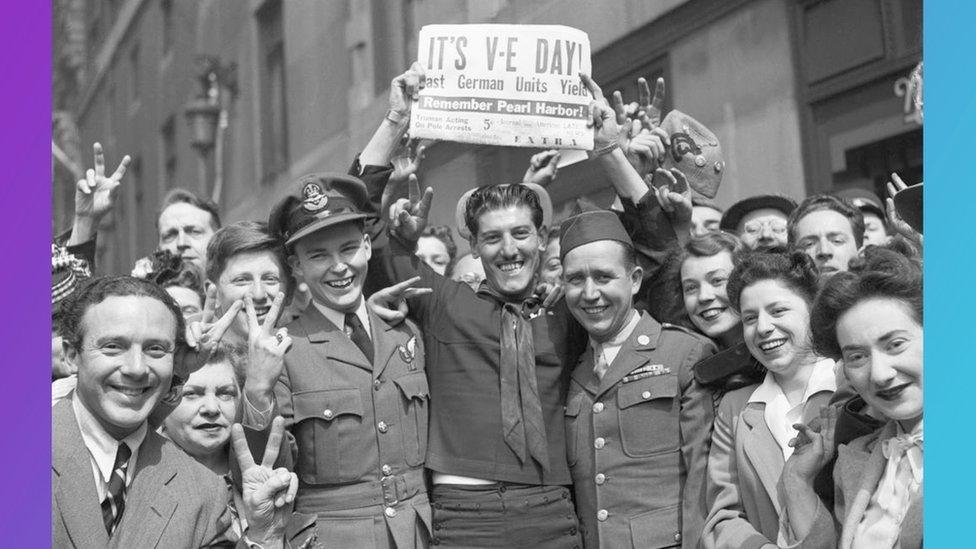VE Day: What is it, when is it and why do we remember?
- Published

VE Day marked the end of fighting in Europe towards the end of World War II
VE Day - or 'Victory in Europe Day' - marks the day towards the end of World War Two (WW2) when fighting against Nazi Germany in Europe came to an end.
On 8 May 1945, Prime Minister Winston Churchill made an announcement on the radio at 3pm that the war in Europe had come to an end, following Germany's surrender the day before.
Read on to find out more about what happened on VE Day and how World War Two ended.
How was VE Day celebrated?
There were celebrations and street parties when the end of WW2 was announced
By the beginning of 1945, the German army had been weakened and defeat looked likely.
Tuesday 8 May, 1945, was an emotional day that millions of people had been waiting for.
Many people were extremely happy that the fighting had stopped and there were big celebrations and street parties.
Huge crowds - with lots of people dressed in red, white and blue - gathered outside Buckingham Palace in London.
This photo shows Winston Churchill on the balcony of Buckingham Palace alongside the Royal Family (Princess Elizabeth, who became Queen Elizabeth II, is seen on the left)
Queen Elizabeth II's secret VE Day party
They cheered as King George VI and his family, including Queen Elizabeth II - who was a princess at the time - and Princess Margaret, came out onto the balcony to greet everybody.
The princesses were allowed to leave the palace and celebrate with crowds outside, although they had to do it secretly.
In a rare interview with the 91热爆 in 1985, Queen Elizabeth said: "When the excitement of the floodlights being switched on got through to us, my sister and I realized that we couldn't see what the crowds were enjoying so we asked my parents if we could go out and see for ourselves."
Princess Elizabeth wore her uniform in the crowds to blend in
The future Queen had served as a driver and mechanic during the war for the Auxiliary Transport Service, so she wore her uniform to blend in.
"We cheered the King and Queen on the balcony and then walked miles through the street. I remember lines of unknown people linking arms and walking down Whitehall, all of us just swept along on a tide of happiness and relief," she added.
They even went and did the conga at The Ritz, a luxury hotel in London - Queen Elizabeth described it as "one of the most memorable nights of my life".
Huge crowds took to the streets to celebrate the end of World War Two
Many people also attended church services to thank God for the victory.
London's St Paul's Cathedral held 10 services, which were attended by thousands of people.
But VE Day was also a moment of great sadness and reflection, as millions of people had lost their lives or loved ones in the conflict.
Many had to continue fighting in other battles in other parts of the world away from Europe and lots of people were being kept as prisoners of war abroad.
Who signed the WWII surrender?
It was announced on 1 May 1945 that the leader of Nazi Germany, Adolf Hitler had died.
After Hitler's death, leadership of Nazi Germany passed to other officials. By this point it was obvious that the war in Europe was coming to an end and that the Nazis had lost.
On 7 May 1945 in Reims, France, Alfred Jodl, a high-ranking general in the Nazi Armed Forces, signed a surrender document.
Why did Nazi Germany surrender twice?
The Soviet leader, Joseph Stalin, an ally of Britain and America in the war, refused to accept the surrender signed in Reims - it's thought that he was suspicious of the motives of his Western Allies and Nazi Germany.
He insisted that the treaty was officially agreed in Berlin, the following day, so today Russia celebrates VE Day one day later than the rest of Europe, on 9 May.
Was VE Day the end of World War Two?
WATCH: What does VE Day mean to my grandfather?
Even though VE Day marked victory for Europe over Germany, it did not mark the end of World War Two.
In his VE Day announcement, Winston Churchill said: "We may allow ourselves a brief period of rejoicing, but let us not forget for a moment the toil and efforts that lie ahead."
Even after 8 May, many soldiers, sailors and pilots were sent to the east to fight against the Japanese, who had not yet surrendered.
Even though Churchill had announced victory over Nazi Germany, VE Day did not mark the end of World War Two
2 September is also known as VJ Day, as this is the day in 1945 when Japanese leaders signed a document to officially surrender.
What happened after World War Two?
The end of the war did not mean the end of food rations, which is when people were only allowed to buy a certain amount of food each week
While the war was over, it was not the end of hardship.
Millions of people had lost loved ones and their lives had been turned upside down by the fighting.
The nation had to rebuild as the war had been so expensive. Clothing and food rationing remained in place.
By the end of WW2, the foundations had also been laid for something called the Cold War, which would last until December 1991.
- Published27 January 2013
- Published26 January 2022
- Published17 July
